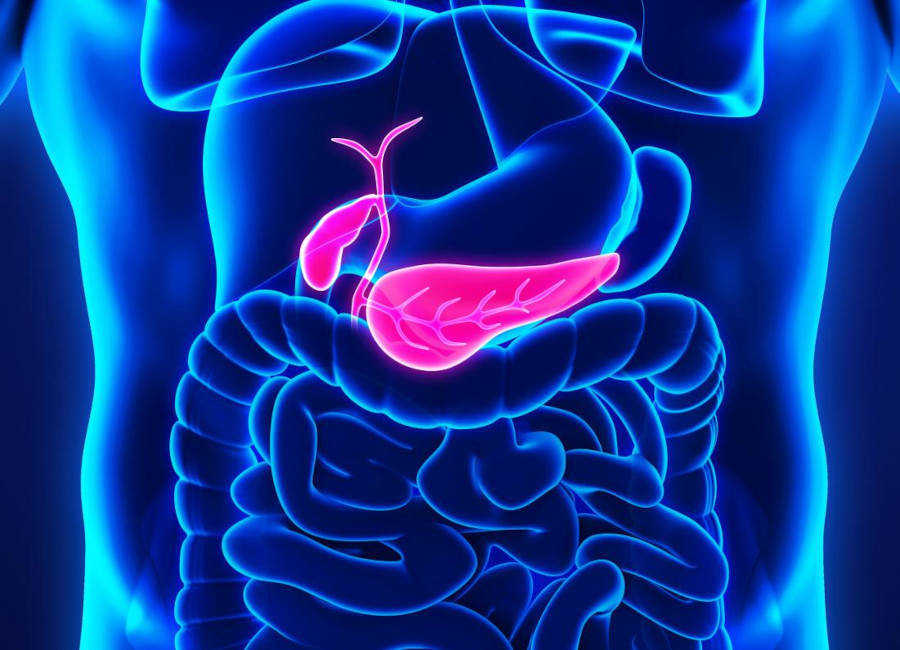The pancreas is a unique and essential organ nestled deep in the abdomen. It performs a dual role in the human body—digestive and endocrine—making it indispensable to both the breakdown of food and the regulation of blood sugar.
1. Anatomy and Location
The pancreas is a soft, elongated gland that lies horizontally across the back of the abdomen, just behind the stomach. It’s typically 6 to 10 inches (15 to 25 cm) in length and has three main parts:
- Head: The wider end, located in the curve of the duodenum (the first segment of the small intestine).
- Body: The middle section, which lies behind the stomach.
- Tail: The narrow end, which extends toward the spleen on the left side of the body.
The pancreas is well-vascularised, meaning it has a rich blood supply that supports its intense metabolic activity. It connects to the duodenum via the pancreatic duct, often merging with the common bile duct from the liver and gallbladder before entering the small intestine.
2. The Dual Functions of the Pancreas
The pancreas is both an exocrine and an endocrine organ.
A. Exocrine Function: Digestive Powerhouse
Approximately 95% of the pancreas is devoted to its exocrine function: producing and releasing digestive “enzymes”.
- Specialised cells called acinar cells secrete “enzymes” into small ducts that converge into the main pancreatic duct.
- These “enzymes” are released into the duodenum where they break down food into absorbable units.
Major Pancreatic “Enzymes”:
- Amylase: Breaks down complex carbohydrates into simple sugars.
- Lipase: Breaks down fats into fatty acids and glycerol.
- Proteases (e.g., trypsin, chymotrypsin): Break down “proteins” into “amino acids”.
- Nucleases: Break down DNA and RNA from consumed cells.
These “enzymes” are secreted in an inactive form and activated only in the intestine to prevent self-digestion of the pancreas itself.
B. Endocrine Function: Hormonal Regulation of Blood Sugar
Scattered throughout the pancreas are about 1 million tiny clusters of hormone-producing cells called the islets of Langerhans. These clusters release hormones directly into the bloodstream.
Key Hormones Produced:
- Insulin (from beta cells): Lowers blood glucose by helping cells absorb sugar.
- Glucagon (from alpha cells): Raises blood glucose by stimulating the liver to convert stored glycogen into glucose.
- Somatostatin (from delta cells): Regulates the secretion of both insulin and glucagon.
- Pancreatic polypeptide (from PP cells): Regulates pancreatic secretions and gastrointestinal functions.
This intricate hormone system keeps the body’s blood sugar in balance—homeostasis—which is critical for energy production and overall health.
3. The Importance of the Pancreas
The pancreas plays a central role in overall health. If it fails to function properly, multiple systems in the body are affected.
- Digestive Health: Without pancreatic “enzymes”, fats, proteins, and complex carbs cannot be effectively broken down or absorbed, leading to malnutrition, weight loss, bloating, and diarrhoea.
- Blood Sugar Regulation: A malfunctioning pancreas may not produce enough insulin, causing elevated blood sugar and potentially leading to diabetes mellitus. This condition, if unmanaged, affects the eyes, kidneys, nerves, and heart.
4. Common Pancreatic Disorders
a. Diabetes Mellitus
- Type 1 Diabetes: An autoimmune condition where the pancreas fails to produce insulin due to the destruction of beta cells.
- Type 2 Diabetes: The pancreas produces insulin, but the body becomes resistant to it, often associated with poor diet, obesity, and inactivity.
b. Pancreatitis
- Inflammation of the pancreas. It may be acute (sudden) or chronic (ongoing).
- Causes include gallstones, alcohol abuse, infections, medications, or high triglyceride levels.
- Symptoms: Severe abdominal pain, nausea, vomiting, fever.
c. Pancreatic Cancer
- A highly aggressive form of cancer that often develops silently.
- Symptoms may include jaundice, weight loss, and abdominal pain.
- It’s often diagnosed in later stages due to its deep abdominal location and subtle early symptoms.
d. Exocrine Pancreatic Insufficiency (EPI)
- The pancreas doesn’t produce enough digestive “enzymes”.
- Leads to nutrient malabsorption, fatty stools, weight loss, and fatigue.
- Common in people with chronic pancreatitis or cystic fibrosis.
5. Supporting Pancreatic Health
Keeping the pancreas healthy is essential for digestion and metabolic balance. Some tips include:
- Eat a whole food diet: Rich in fruits, vegetables, and fibre. Avoid processed foods and excessive refined sugars.
- Stay hydrated: Water helps with digestion and detoxification.
- Avoid excessive alcohol: A leading cause of pancreatitis.
- Exercise regularly: Helps regulate blood sugar and insulin sensitivity.
- Limit toxins: Environmental chemicals, smoking, and poor dietary choices can stress the pancreas.
- Herbal support: Some herbs traditionally used for pancreatic health include bitter melon, dandelion root, burdock root, and milk thistle.
Conclusion
The pancreas is more than just a digestive gland—it is a master regulator of blood sugar and a key player in nutrient assimilation. Despite being often overlooked, it performs complex tasks every moment of the day. Taking care of your pancreas through a healthy lifestyle and early detection of issues can help prevent serious illnesses and support long-term wellness.
This article is copyrighted by Ital is Vital, 2025. Want to re-post this article? Visit our guidelines.
DISCLAIMER: THIS WEBSITE DOES NOT PROVIDE MEDICAL ADVICE
The information, including but not limited to, text, graphics, images and other material contained on this website are for informational purposes only. The purpose of this website is to promote broad consumer understanding and knowledge of various health topics. It is not intended to be a substitute for professional medical advice, diagnosis or treatment. Always seek the advice of your physician or other qualified health care provider with any questions you may have regarding a medical condition or treatment and before undertaking a new health care regimen, and never disregard professional medical advice or delay in seeking it because of something you have read on this website.
